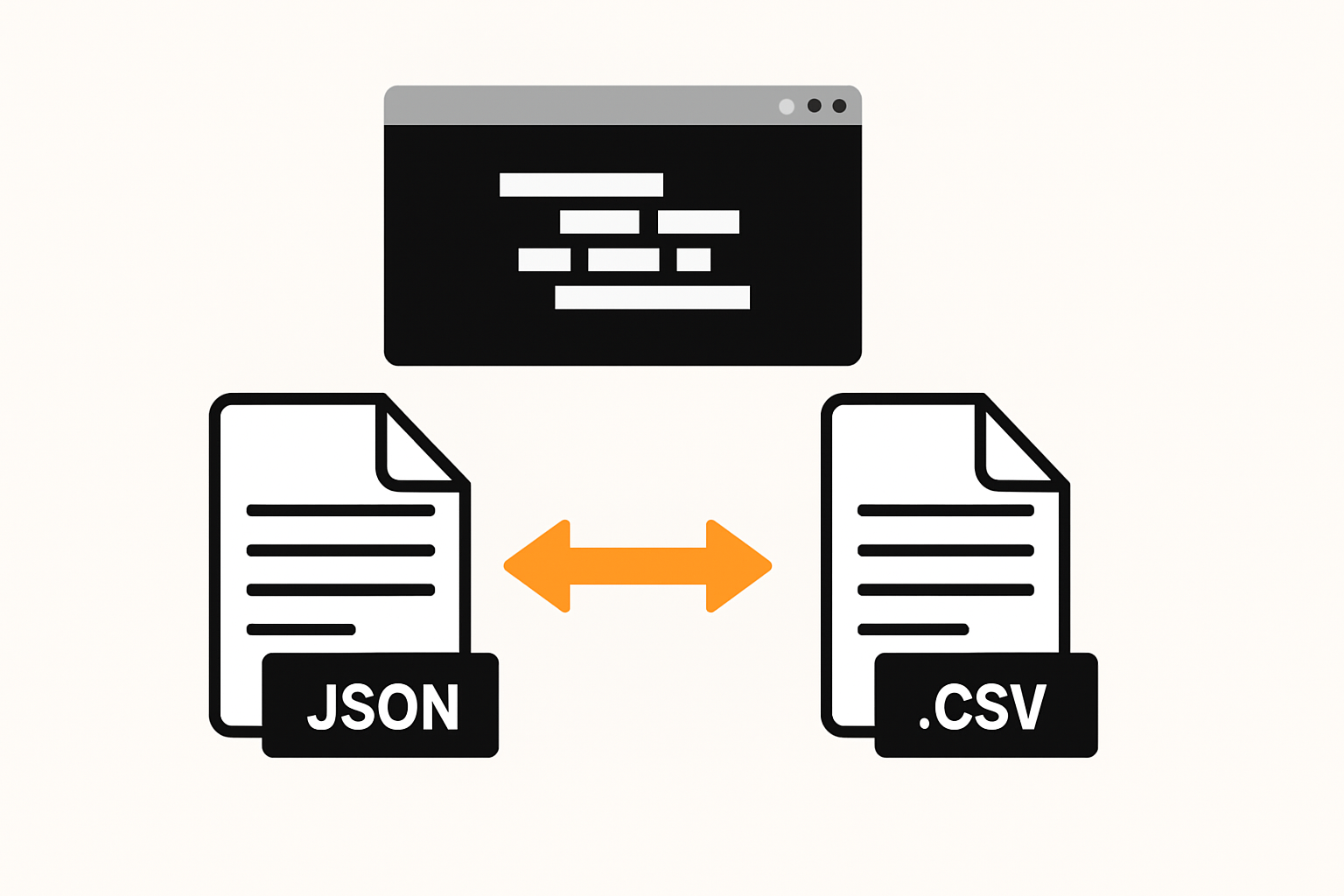
12
Convert JSON to CSV & CSV to JSON: Step-by-Step Guide
Learn how to easily convert JSON to CSV and CSV to JSON with tools, code examples, and step-by-step guides for developers and beginners.
Step-by-Step Guide: Converting JSON to CSV and CSV to JSON
Introduction: Why Data Conversion Matters
In today’s digital world, data is everything. Whether you’re managing user information, analyzing reports, or working on APIs, chances are you’ll deal with JSON and CSV formats.
But here’s the challenge:
- JSON (JavaScript Object Notation) is structured and widely used for APIs.
- CSV (Comma-Separated Values) is simple and preferred for spreadsheets and bulk data handling.
Often, you’ll need to convert JSON to CSV for reporting or CSV to JSON for APIs. The good news? With the right tools and techniques, this process is quick and easy.
In this guide, we’ll walk you through both conversions—step by step—with examples, tools, and best practices.
JSON vs CSV: What’s the Difference?
JSON (JavaScript Object Notation)
- Structured data format (key-value pairs).
- Human-readable and machine-friendly.
- Commonly used for APIs and web apps.
Example JSON:
[
{
"name": "Alice",
"age": 28,
"city": "New York"
},
{
"name": "Bob",
"age": 34,
"city": "Los Angeles"
}
]
CSV (Comma-Separated Values)
- Tabular data format (rows and columns).
- Easy to open in Excel, Google Sheets, or any text editor.
- Common for data storage, reporting, and bulk uploads.
Example CSV:
name,age,city Alice,28,New York Bob,34,Los Angeles
Why Convert Between JSON and CSV?
- JSON to CSV:
- For analytics, spreadsheets, and bulk database imports.
- Easier for non-developers to read.
- CSV to JSON:
- For APIs, configuration files, or applications that consume JSON.
- Makes data structured and machine-friendly.
Step-by-Step: Converting JSON to CSV
1. Using Online Tools
- ConvertCSV.com
- JSON-CSV.com
- Mr. Data Converter
These are quick for small files but not ideal for automation.
2. Using Python
Python makes this super easy with the pandas library.
Code Example:
import pandas as pd
import json
# Load JSON file
with open("data.json") as f:
data = json.load(f)
# Convert to DataFrame
df = pd.DataFrame(data)
# Save as CSV
df.to_csv("output.csv", index=False)
Output: A clean CSV file ready for Excel or Google Sheets.
3. Using JavaScript (Node.js)
const fs = require("fs");
// Load JSON file
const data = require("./data.json");
// Convert JSON to CSV
const headers = Object.keys(data[0]).join(",") + "\n";
const rows = data.map(obj => Object.values(obj).join(",")).join("\n");
fs.writeFileSync("output.csv", headers + rows);
4. Using Excel or Google Sheets
- Open a JSON-to-CSV converter online.
- Import the CSV into Excel or Google Sheets.
- Save and format for reporting.
Step-by-Step: Converting CSV to JSON
1. Using Online Tools
- ConvertCSV.com
- CSVJSON.com
- Paste your CSV → Get JSON instantly.
2. Using Python
import pandas as pd
# Load CSV file
df = pd.read_csv("data.csv")
# Convert to JSON
df.to_json("output.json", orient="records", lines=False)
Output: A structured JSON file.
3. Using JavaScript (Node.js)
const fs = require("fs");
// Load CSV file
const csvData = fs.readFileSync("data.csv", "utf8");
// Convert CSV to JSON
const [headerLine, ...lines] = csvData.split("\n");
const headers = headerLine.split(",");
const jsonData = lines.map(line => {
const values = line.split(",");
return headers.reduce((obj, header, i) => {
obj[header] = values[i];
return obj;
}, {});
});
fs.writeFileSync("output.json", JSON.stringify(jsonData, null, 2));
4. Using Excel or Google Sheets
- Open CSV in Excel/Sheets.
- Export or download as JSON using add-ons or plugins.
Advanced Conversion Tips
Handling Nested JSON
Sometimes JSON has nested structures:
{
"name": "Alice",
"address": {
"street": "123 Main St",
"city": "New York"
}
}
When converting to CSV, you may flatten it like:
name,address.street,address.city Alice,123 Main St,New York
Large File Handling
- Use command-line tools like jq (for JSON) or csvkit (for CSV).
- Stream data instead of loading all at once (in Python or Node.js).
Common Mistakes to Avoid
- Ignoring special characters (quotes, commas inside data).
- Losing leading zeros (e.g., postal codes in CSV).
- Forgetting UTF-8 encoding for international characters.
- Not validating JSON after conversion.
Real-World Use Cases
- eCommerce: Export product data as CSV for bulk upload, then convert back to JSON for APIs.
- Data Analysis: Convert API responses (JSON) into CSV for Excel-based reporting.
- Web Development: Use CSV for content editing, then convert to JSON for a website’s backend.
Future of Data Formats
- JSON remains dominant for APIs.
- CSV continues as the easiest for humans to edit.
- Hybrid solutions like Parquet and Avro are rising for big data but are more technical.
For most developers and businesses, mastering JSON ↔ CSV conversion is still essential.
Conclusion: Converting Data Made Simple
Whether you’re a developer, analyst, or business owner, understanding how to convert JSON to CSV and CSV to JSON is a valuable skill.
- Use online tools for quick conversions.
- Use Python or JavaScript for automation.
- Always validate your data after conversion.
Call to Action: Start practicing with your own data today. Convert a JSON API response into a CSV report—or turn a CSV dataset into JSON for your app. The more you practice, the faster and more efficient your data workflows will become.
Contact
Missing something?
Feel free to request missing tools or give some feedback using our contact form.
Contact Us